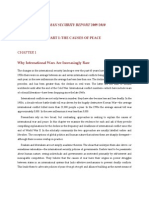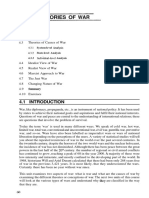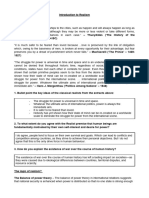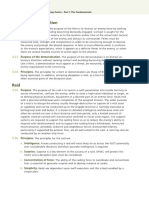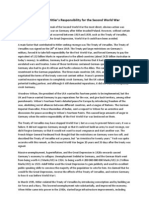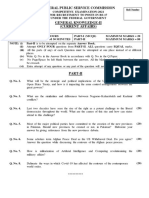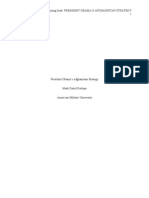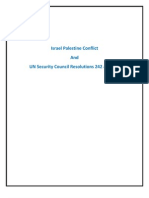War and world politics
War and world politics
Uploaded by
hiba2005aarabCopyright:
Available Formats
War and world politics
War and world politics
Uploaded by
hiba2005aarabCopyright
Available Formats
Share this document
Did you find this document useful?
Is this content inappropriate?
Copyright:
Available Formats
War and world politics
War and world politics
Uploaded by
hiba2005aarabCopyright:
Available Formats
Baylis, Smith and Owens: The Globalization of World Politics 7e
Revision guide
Chapter 14: War and world politics
War is organized violence among political entities, including both states and non-state
actors.
War has occurred frequently in history, but changes with context.
Many kinds of groups can wage war, but in order to do so they have to ‘organize violence’ or
create an armed force.
A ‘war and society’ approach to the study of war looks at how war has shaped society and at
how society has shaped war.
Strategy is a plan to make the war serve a political purpose, while tactics are the techniques
that armed forces use to win battles.
International war is a war fought between two or more sovereign states.
A civil war is a war fought inside a sovereign state, but which in practice may involve many
different international actors.
Wars connect the combatant societies; through war, the parties to the conflict shape one
another.
Wars lead to the global circulation of people, goods, and ideas.
Wars can shape world politics as a whole and have long-lasting consequences.
Clausewitz developed two trinities to describe the nature of war: a primary one consisting of
passion, chance and reason, and a second one consisting of political leadership, armed
forces, and the people.
Clausewitz divided war into two types: limited war fought for a purpose less than political
existence, and total war in which existence was at stake.
Clausewitz made a distinction between ‘real war’, or war as it actually happens, and ‘true
war’, the inherent tendency of war to escalate.
War for Clausewitz is a continuation of politics between the combatant societies with the
addition of other— violent—means.
Political purposes can both limit and fuel the violence of war.
Armed force is an important basis for political power, and the types of military technology
available shape politics.
Modern states claimed a monopoly of legitimate violence within their territories.
Nationalism and war had a symbiotic relationship: nationalism motivated many people to go
to war, while war increased national feeling.
Since Western states were both sovereign states and empires, their wars had both
international and global dimensions.
State-building in Europe meant imperial wars in the non-European world.
Empires were concerned with internal security and used armies and security forces raised
from colonized populations.
Great powers used military assistance to intervene in the global South after decolonization.
War and society in the global South and North have become interconnected in new ways in
the war on terror.
© Oxford University Press, 2017.
You might also like
- Antulio J. Echevarria - Military Strategy A Very Short IntroductionDocument131 pagesAntulio J. Echevarria - Military Strategy A Very Short Introduction970077No ratings yet
- Charles Oliviero - Praxis Tacticum - The Art, Science and Practice of Military Tactics-Double Dagger Books (2021)Document342 pagesCharles Oliviero - Praxis Tacticum - The Art, Science and Practice of Military Tactics-Double Dagger Books (2021)Renato do Prado Kloss100% (3)
- Multi-Service Tactics, Techniques, and Procedures For TheDocument140 pagesMulti-Service Tactics, Techniques, and Procedures For TheOtis1964100% (1)
- War and PeaceDocument39 pagesWar and PeaceAleezay ChaudhryNo ratings yet
- Trends of WarDocument15 pagesTrends of WarHarsheen SidanaNo ratings yet
- War PolicyDocument12 pagesWar Policymarlou agustinNo ratings yet
- Types of WarDocument1 pageTypes of WarPatrick dcostaNo ratings yet
- 06 Modern Types of WarDocument14 pages06 Modern Types of WarFranz JosephNo ratings yet
- ZZ War and Armed Conflict Faculty NotesDocument12 pagesZZ War and Armed Conflict Faculty NotesPacoNo ratings yet
- War and Its CausesDocument19 pagesWar and Its CausesHaniya KhanNo ratings yet
- A Civil War Is A War Between Organized Groups Within The Same Nation State or RepublicDocument6 pagesA Civil War Is A War Between Organized Groups Within The Same Nation State or RepublicnimshiferNo ratings yet
- 01 30 2024 John Mearsheimers Read Ahead War International Politics - January 30 2024Document17 pages01 30 2024 John Mearsheimers Read Ahead War International Politics - January 30 2024PACLEB, ERICA JOYNo ratings yet
- War Is Merely An IdeaDocument4 pagesWar Is Merely An IdeaRVictoryNo ratings yet
- 20092010HumanSecurityReport Part1 CausesOfPeaceDocument92 pages20092010HumanSecurityReport Part1 CausesOfPeaceRazvan DanielNo ratings yet
- Changing Character of War-1Document3 pagesChanging Character of War-1Sardar Abdul BasitNo ratings yet
- Characteristics of A New WarDocument4 pagesCharacteristics of A New WarSOULAIMANE EZZOUINENo ratings yet
- Name - Muhammad ZakriaDocument3 pagesName - Muhammad ZakriaZakriya Khan ZakriyaNo ratings yet
- A4Document2 pagesA4Mahnoor KhanNo ratings yet
- War and PeaceDocument23 pagesWar and PeaceJanvi SinghiNo ratings yet
- INTLAW 1 Final Paper War & Consequences Ukraine WarDocument20 pagesINTLAW 1 Final Paper War & Consequences Ukraine WarSean Christian DinglasanNo ratings yet
- 04 Theories of WarDocument9 pages04 Theories of WarFranz JosephNo ratings yet
- Chapter 3 - Contending Theories of War and PeaceDocument8 pagesChapter 3 - Contending Theories of War and PeaceMohamed ShiineNo ratings yet
- Hutchinson - Nationalism and WarDocument14 pagesHutchinson - Nationalism and WarermineaboutNo ratings yet
- War and Conflict SociologyDocument2 pagesWar and Conflict SociologyOnur MutluayNo ratings yet
- Go Pol War and PeaceDocument2 pagesGo Pol War and PeaceAlkmini LouizouNo ratings yet
- War & PeaceDocument11 pagesWar & PeaceAhmad NaqiuddinNo ratings yet
- O W: C, D, R D - A S L R B: N AR Oncepts Efinitions Esearch ATA Hort Iterature Eview and IbliographyDocument51 pagesO W: C, D, R D - A S L R B: N AR Oncepts Efinitions Esearch ATA Hort Iterature Eview and IbliographyowliyoNo ratings yet
- The Globalization of World Politics - An Introduction To International Relations 9th Edition CHPT 5Document15 pagesThe Globalization of World Politics - An Introduction To International Relations 9th Edition CHPT 5Georgette KeatingNo ratings yet
- Lec 1 & 2Document41 pagesLec 1 & 2Ahmad RamadanNo ratings yet
- Causes of War CSS Notes IRDocument9 pagesCauses of War CSS Notes IRNawalRamayNo ratings yet
- Why Nations Go To War?: Presented byDocument20 pagesWhy Nations Go To War?: Presented byBabar IjazNo ratings yet
- Lecture 9Document70 pagesLecture 9hibaamjad110No ratings yet
- Causes of Conflict LevelsDocument34 pagesCauses of Conflict Levelsusamaghaffar250No ratings yet
- WarDocument8 pagesWarAshio JosephNo ratings yet
- Summary - Chap 01 - Nye & Welch 2014Document5 pagesSummary - Chap 01 - Nye & Welch 2014mariakibtia1907No ratings yet
- Lse - Ac.uk Storage LIBRARY Secondary Libfile Shared Repository Content Kaldor, M Kaldor Defence New Wars 2013 Kaldor Defence New Wars 2013Document17 pagesLse - Ac.uk Storage LIBRARY Secondary Libfile Shared Repository Content Kaldor, M Kaldor Defence New Wars 2013 Kaldor Defence New Wars 2013ccperfectoNo ratings yet
- O W: C, D, R D - A S L R B: N AR Oncepts Efinitions Esearch ATA Hort Iterature Eview and IbliographyDocument49 pagesO W: C, D, R D - A S L R B: N AR Oncepts Efinitions Esearch ATA Hort Iterature Eview and IbliographyhernanNo ratings yet
- Week 2Document20 pagesWeek 2shinaejjjNo ratings yet
- 2A - 5 - 2 - REALISM - Politics For IndiaDocument12 pages2A - 5 - 2 - REALISM - Politics For IndiaABHI PIMNo ratings yet
- War Vs ConflictDocument5 pagesWar Vs ConflictLatifur RahmanNo ratings yet
- TheoriesDocument56 pagesTheoriesasfiiNo ratings yet
- Unreality of Realism SUMMARYDocument2 pagesUnreality of Realism SUMMARYNicolò GrassoNo ratings yet
- Cold War Is A Typical Example of Cooperation and Conflict in IRDocument5 pagesCold War Is A Typical Example of Cooperation and Conflict in IRVinoli SoysaNo ratings yet
- Small Wars Journal - Hybrid War - Old Concept, New Techniques - 2015-03-02Document4 pagesSmall Wars Journal - Hybrid War - Old Concept, New Techniques - 2015-03-02Lucas Simões Marques BragaNo ratings yet
- IR BK Review 2'2Document7 pagesIR BK Review 2'2Jibril AdeyeyeNo ratings yet
- Analyzing The Cold War Through The Lens of International TheoriesDocument6 pagesAnalyzing The Cold War Through The Lens of International TheoriesHasan ShohagNo ratings yet
- What Are The Causes of War - EssayDocument13 pagesWhat Are The Causes of War - EssayMike Going100% (1)
- War and Peace International RelationsDocument4 pagesWar and Peace International RelationsBelle Reese PardilloNo ratings yet
- IR Week 1Document19 pagesIR Week 1Charleen NxumaloNo ratings yet
- Io 22Document6 pagesIo 22ebi4567890No ratings yet
- Causes of WarDocument4 pagesCauses of WarHarry HurdNo ratings yet
- Low Intensity ConflictDocument27 pagesLow Intensity ConflictkleephNo ratings yet
- Introduction To RealismDocument4 pagesIntroduction To Realismayah sadiehNo ratings yet
- HMT Term PaperDocument9 pagesHMT Term PaperJulius Del PradoNo ratings yet
- Untitled DocumentDocument5 pagesUntitled DocumentlaNo ratings yet
- One World Many Theories PDFDocument17 pagesOne World Many Theories PDFEva Alam Nejuko ChanNo ratings yet
- War, Violence, Terrorism, and Our Present World: A Timeline of Modern PoliticsFrom EverandWar, Violence, Terrorism, and Our Present World: A Timeline of Modern PoliticsNo ratings yet
- Causes of WarDocument131 pagesCauses of WarTayfun ErbugaNo ratings yet
- Running Head: Syria Civil War and Ingos 1Document14 pagesRunning Head: Syria Civil War and Ingos 1sanaNo ratings yet
- War and Its TypesDocument3 pagesWar and Its TypesSajid KhattakNo ratings yet
- 1.3 Theoretical Approaches To International Relations AnnotatedDocument25 pages1.3 Theoretical Approaches To International Relations Annotatedeletalobo024No ratings yet
- Robert Gilpin - Theory of Hegemonic WarDocument24 pagesRobert Gilpin - Theory of Hegemonic Wardeea09100% (1)
- Prologue From Visions of Freedom byDocument8 pagesPrologue From Visions of Freedom byRenee Feltz100% (1)
- Feint and Demonstration: Purpose of The FeintDocument1 pageFeint and Demonstration: Purpose of The FeintGrozny GroznyNo ratings yet
- Hitler's Responsibility For The Second World WarDocument2 pagesHitler's Responsibility For The Second World WarsharmallamaNo ratings yet
- Jacob, Happymon - Line On Fire - Ceasefire Violations and India-Pakistan Escalation Dynamics-Oxford University Press (2019)Document398 pagesJacob, Happymon - Line On Fire - Ceasefire Violations and India-Pakistan Escalation Dynamics-Oxford University Press (2019)BagaNo ratings yet
- HMT Term PaperDocument9 pagesHMT Term PaperJulius Del PradoNo ratings yet
- Sword 4 BoydDocument46 pagesSword 4 Boydbovine splendor100% (4)
- Stablepdf23528511.pdfrefreqid Excelsior09&Ab Segments &origin &initiatDocument9 pagesStablepdf23528511.pdfrefreqid Excelsior09&Ab Segments &origin &initiatRohan RaiNo ratings yet
- On Western Sahara UNSC Has Two Abstentions in Even Extending MINURSO 6 Months, Resolution HereDocument5 pagesOn Western Sahara UNSC Has Two Abstentions in Even Extending MINURSO 6 Months, Resolution HereMatthew Russell LeeNo ratings yet
- Aztec TacticsDocument8 pagesAztec TacticsMax R BrownNo ratings yet
- XZNXNZDocument17 pagesXZNXNZKinza ZebNo ratings yet
- What Is Cold WarDocument8 pagesWhat Is Cold WarRukhsar TariqNo ratings yet
- Freedom of Information: MOD Requests To 1 December 2009Document7 pagesFreedom of Information: MOD Requests To 1 December 2009Andrew HollinrakeNo ratings yet
- What Agenda For Human Security in The Twenty-First Century?Document138 pagesWhat Agenda For Human Security in The Twenty-First Century?zeonNo ratings yet
- Osprey - Vanquished - Crushing Defeats From Ancient Rome To The 21st Century (OCR-Ogon) PDFDocument320 pagesOsprey - Vanquished - Crushing Defeats From Ancient Rome To The 21st Century (OCR-Ogon) PDFSamuel Môyzellys100% (2)
- Chapter 32 World War 2Document7 pagesChapter 32 World War 2sherel fernandezNo ratings yet
- Css Current Affairs 2021Document1 pageCss Current Affairs 2021Afshan shabbirNo ratings yet
- 2a. BTL of Belonia Bulge-Maj KhakedDocument9 pages2a. BTL of Belonia Bulge-Maj Khakedmonir.ridoyNo ratings yet
- Obama's Afghanistan Strategy - Written January 2010Document6 pagesObama's Afghanistan Strategy - Written January 2010mdderhamNo ratings yet
- Anti-Aircraft Journal - Dec 1950Document68 pagesAnti-Aircraft Journal - Dec 1950CAP History Library100% (1)
- Disarmament 1Document34 pagesDisarmament 1IlmuncMakesuillNo ratings yet
- Countering Hybrid War PDFDocument19 pagesCountering Hybrid War PDFjulianNo ratings yet
- Human Rights And: Nternational Umanitarian AWDocument15 pagesHuman Rights And: Nternational Umanitarian AWMeghna Singh100% (1)
- ww1 NotesDocument28 pagesww1 NotesAshaliNo ratings yet
- Un General Assembly and Peacekeeping OperationsDocument19 pagesUn General Assembly and Peacekeeping OperationsAbhipsha MohantyNo ratings yet
- UN Resolutions 242 and 338Document8 pagesUN Resolutions 242 and 338Asma IlyasNo ratings yet
- Class 12th Political Science Unit Test ch-1Document3 pagesClass 12th Political Science Unit Test ch-1aggarwalsakshi0002No ratings yet
- Success and Failure of UN Peacekeeping OperatiDocument33 pagesSuccess and Failure of UN Peacekeeping Operatithaotrang tranNo ratings yet













